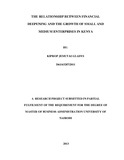| dc.description.abstract | Financial inclusion offers incremental and complementary solutions to tackle poverty and to promote inclusive development. Financial deepening plays an important role in reducing risk and vulnerability for disadvantaged groups, and increasing the ability of individuals and households to access basic services like health and education, thus having a more direct impact on poverty reduction (Lavine, 1997). The performance and long- run economic growth and welfare of a country is related to its degree of financial development which is measured by factors such as size, depth, access and the efficiency and stability of its financial system, which includes its markets, intermediaries and range of assets, institutions and regulation. A crucial element in the development of the SME sector is access to finance, particularly to bank financing, given the relative importance of the banking sector in serving this segment. Firm-level data collected by the World Bank show that access to finance is perceived as one of the main obstacles to doing business (World Bank, various years). The purpose of this study was to establish the relationship between financial deepening and the growth of Small and medium enterprises in Kenya. This study therefore, sought to answer the question whether there is a relationship between financial deepening and the growth of small and medium enterprises (SMEs) in Kenya. This study adopted both descriptive and exploratory designs. The population for this study consisted of all the Kenya top 100 medium sized companies year 2012. The study sampled 20 SMEs in Nairobi area. Secondary data was collected from the selected SMEs financial statements. The study used both descriptive and inferential statistics in analyzing the data. Chi-square test was also applied in the study to test the null hypotheses on the fact that if the p value for the calculated Chi-square is p >0.05, then the null hypothesis is accepted. The data was entered into the statistical package for social science (SPSS) and analyzed using descriptive, correlation and regression analysis. From the findings of the study, averages for capitalization, savings and loans for the 20 SMEs extracted from the financial and annual statements reflected an upward increase over the 5 year period, with the highest being in year 2012. From the findings, it is clear that there was a positive correlation between gross domestic savings and level of capitalization also; there was a positive correlation between domestic credit to SMEs sector and level of capitalization. The study revealed that a unit increase in gross domestic savings will cause an increase in level of capitalization. The study further found that a unit increase in domestic credit to SMEs sector will cause an increase in level of capitalization. The study concluded that finance whether owned or borrowed, is needed by SMES to expand so as to maximize profit. The study also concluded that small and medium sized enterprises in both developing and developed countries plays important roles in the process of industrialization and economic growth, by significantly contributing to employment generation, income generation and catalyzing development in urban and rural areas. The study recommends the need for further studies on the major structural impediments that prevent the Kenyan financial system from reaching its full potential. | en |

